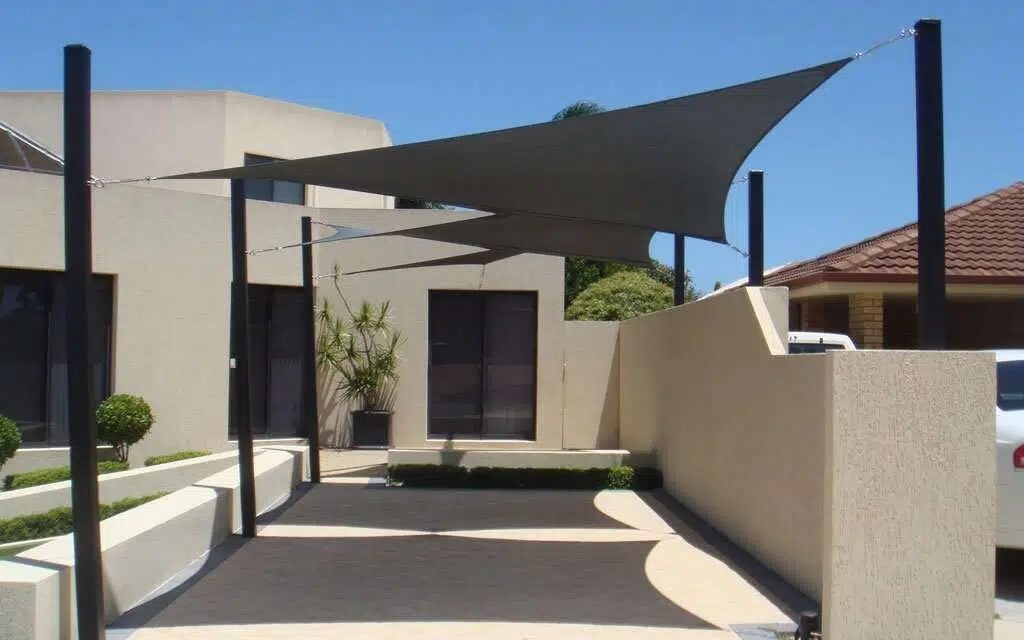The main image is courtesy of Rainbow Shade.
During a vacation to Turks and Caicos Islands, we noticed shade sails everywhere, as islanders use them to protect against sun, wind, sand and rain. One restaurant, Coco Bistro, is set amidst the largest palm grove on the island of Providenciales and featured an amazing structure of shade sails affixed high into the grove’s tree tops. Palm canopies were augmented with sail canvas for outdoor seating even during inclement weather.
Shade sails are versatile, practical, low maintenance and easy to install. They are available in a range of colors, durability, and price points which make them the perfect protection against harsh sun, rain, hail, leaves or whatever else might fall from above.
Table of Contents
- What are Shade Sails?
- What are the Uses and Benefits of Shade Sails?
- How to Choose the Right Shade Sail
- Best Shade Sails Brands
- Shade Sail Resources
What are Shade Sails?
Unlike the ubiquitous sun umbrellas, shade sails allow more coverage per square foot to protect against ultraviolet rays, rain and various elements that may fall from above. Sun or Shade sails are widely used to cover entire patios, swimming pools, and decks, unlike sun umbrellas, which are typically a standard 9 feet or 108 inches of canopy.
Available in a variety of shapes – triangular, square, rectangular or circular – sail cloth is suspended by a tensioned structure, usually secured by support poles or to a wall, via wall plates.
Shade sails allow you to cover more area as their high-density polyethylene (HDPE) materials protect against UV rays, while allowing cool breezes to permeate the sail. Proper installation is vital to allow proper drainage of water and optimal performance, as well as a flawless aesthetic.
Whereas sun umbrellas must be affixed to a pole, shade sails can be affixed to a structure, cemented pole or anyplace that is solid enough to support the tension of the sails. This features gives sun shade sails more flexibility in terms of usage, coverage, and design treatment.
How to Install Shade Sails Videos
Coolaroo Shade Sail Installation Overview
How to Install Shade Sails | Mitre 10 Easy As DIY
Benefits and Uses for Shade Sails
Homeowners are learning from commercial applications that shade sails offer a better value for their money to protect residents and their property and belongings against harsh UV rays and inclement weather.
In public and commercial settings, sails can be seen utilized at playgrounds, water parks, outdoor swimming pools, corporate outdoor events, hotels, restaurants and anywhere where protection from the elements is vital during hot, sunny weather or the occasional summer rain storm.
The additional benefits of shade sails for residential uses include:
- Protection for Plants and Young Trees
- Shading for Larger Areas
- Protection for Automobiles
- Design Flexibility
- Affordability
Protection for Plants and Young Trees
We have started to notice the use of shade sails in gardens, especially for late seasonal planting of citrus and other delicate plants and trees. During early growth of delicate trees and plants, sun harshness and heavy downpours can immediately end the life of your gardening endeavors. Sun shade sails help to protect saplings and plants sensitive to harsh weather during crucial growing months.
Shading for Larger Areas
Custom shade sails offer a larger area of protection than the typical nine foot sun umbrella. Custom shapes and sizes of patios, balconies or terraces are easier to cover with shade sails, as they offer more than just the round canopy which is typical with the average umbrella.
Protection for Automobiles
Protection for automobiles that must be parked outside can shield valuable assets from damaging UV rays, leaves, rain and hail. An added benefit is that a shade sail that serves as a carport solution may not require a permit.
Design Flexibility
Shade sails are available in a myriad of shapes, sizes and colors, with many companies offering custom sizing for your particular needs. Shade sails especially go well with modern or contemporary architecture styles. Create an architectural design using different vibrant hues and patterns that allow you to accentuate your home and landscaping, while providing much needed protection from the elements.
Shade sails that are design and installed with ease-of-removal provide an added benefit of having the widest range of natural ambience for an outdoor area throughout the year.
Affordability
Though pricing for a fully installed residential shade sail solution can vary dramatically, shade sails can be quite affordable depending on the size sail and the level of one’s DIY skills. DIY shades can range from as low as $30 to as high as $600. We would advise considering more affordable products and solutions for less demanding usage scenarios, such as in small areas, or infrequent, temporary usage in temperate climates.
If seeking a permanent solution for larger outdoor areas in climates with challenging traits, we strongly recommend getting proposals from professional installers to ensure you are satisfied with the quality of the installation and sails, and expected lifespan of the sails. According to the Landscaping Network, a large, built-to-last professionally installed sail system (often with 2 to 3 sails) can cost between $6,000 to $8,000 for a residential property.
How to Choose the Best Shade Sail
When choosing the best shade sail for your home, define the primary objective for the sail, as this will help prioritize the most important features to look for in your choice of material and brand.
For example, if you live in a hail-prone area you should choose a higher-quality, more durable material with a longer warranty. For sunnier climes throughout the year, make sure that the sail you choose offers ample UV protection, with at least 90-95% UV ray blockage. For hard-to-cover areas, assess the most suitable location for anchoring your sail, either to a structure or to a post that is cemented at the right distance to create the required tension.
Sails can be mounted at angles or flat (with enough slope to allow drainage, allow the passage of winds and to prevent sagging). Make sure you know the strength of the structure to which you will affix your anchor points.
- Traits of Shade Sails
- Which Type of Shade Sail Do I Need?
- Best Shade Sails for Windy Climates
- Best Shade Sails for Rain and Hail
- Best Shade Sails for Architectural Aesthetics
- Best Shade Sails for Flexible and Transformative Environments
Traits of Shade Sails
Here are the most common traits to consider when selecting the type of shade sail for your home.
- Size & Shape
- Durability
- Maintenance
- Waterproofing
- Color Selection & Aesthetics
- Warranty
- Price
- Ease-of-Installation
- Ease-of-Putting-Up and Taking-Down
- Customization Capabilities
- Fire Resistance
Which Type of Shade Sail Do I Need?
Based on your particular situation, choosing a shade sail can be daunting and confusing. Knowing what you want to achieve by installing a shade sail is the first step. Should your sail be functional, transformative, protect against rain, hail, wind, as well as sun? Knowing what you want before you shop is critical, as there are a myriad of shade manufacturers available, and not all shade sails are equal or manufactured to solve the same challenges.
Best Shade Sail for Windy Climates
A high-quality shade sail, that is installed correctly, should be capable of withstanding high winds, although many manufacturers recommend that you take down the sails during hurricane force winds. Since the sails are tensioned, a well-installed, higher quality sail will not flap in the wind the way a flag or umbrella waves violently against gusts. Since wind force is transmitted by the sail to the mountings, the fittings and attachment points need to be well secured.
If you live in an unusually windy area, consider getting customized sails, as they can be installed based on the average wind speed for your particular climate. Shade sails can allow wind through, but the best sails remain sturdy through average wind storms.
Best Shade Sails for Rain and Hail
There is a difference between “waterproof” and “water resistant“. Waterproof shade sails are made from fabric that is impermeable to water. Sails made of PVC (Polyvinyl Chloride) are able to achieve this objective, as they have a durability that is often compared to tarpaulins or the best camping tent materials. Although there are other waterproof materials available, such as synthetic canvas and polyester, the best waterproofing will be achieved with PVC sails.
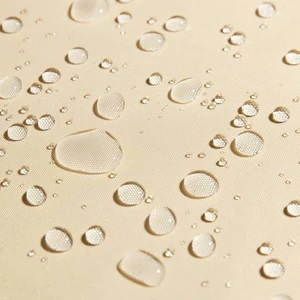
Water resistant shade sail fabrics will “resist” the rains for a period of time, but will eventually become saturated and allow water to penetrate through. Water resistant fabrics, such as woven polyesters, may sometimes be labeled “waterproof”, but true waterproofing will resist soaking up moisture over time. Keep in mind that fabrics that are limited in their “waterproofing” ability, offer an added an advantage of being more “breathable”, allowing more air to flow which will create a more comfortable ambience.
Though being kept dry from rain is a highly desirable benefit, be sure to wisely balance this capability with your local climate and expected usage. For example, if you rarely expect to be outdoors during rainy periods, you will likely want to forego water-resistant features to instead find the best material to foster the ideal outdoor atmosphere for usage during sunny days.
Hail Storm Defense Video from Superior Shade Sails
Examples of Waterproofing & Water-Resistant Shade Sail
- ColourTree Waterproof Shade Sails
- Maanta Waterproof Shade Sails
- Z16 Hail Resistant Sail Fabric from Rainbow Shade
Best Shade Sails for Architectural Aesthetics
Attractive shade sails can be used to create an architectural element to complement any landscaping project by designing a sail project with various colors and sizes. Usually a customized service, architectural shade sails are designed and crafted by professionals in design manufacturing and engineering to provide an enhancement to your property, specific for your needs. These sails use commercial-grade fabrics and hardware to provide a structure that is designed to create notable, protected outdoor spaces, with extended lifespans.
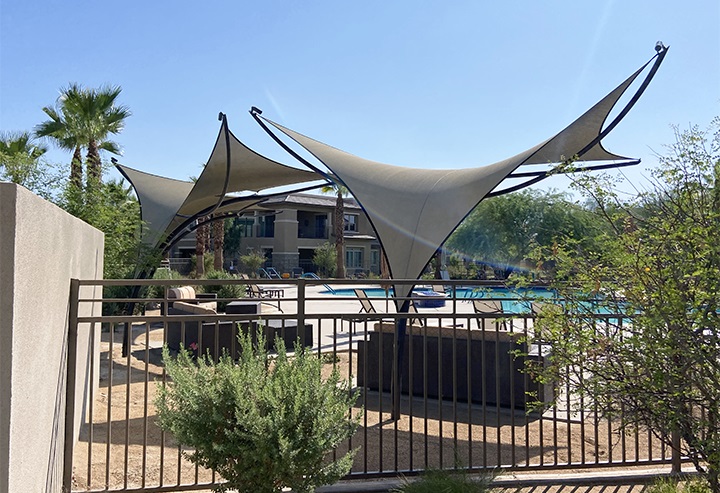
Photo courtesy of Architectural Shade Sails.
Examples of Architectural Shade Sails
Best Shade Sail for Flexible and Transformative Environments
Having a shade sail constructed on your property may appear to be a more of a commitment than you would prefer. Alas, there are transformative, more functional shade sails that allow easy installation and break down when you need it, where you need it. Install your shade sails for your weekend event, take them down soon after.
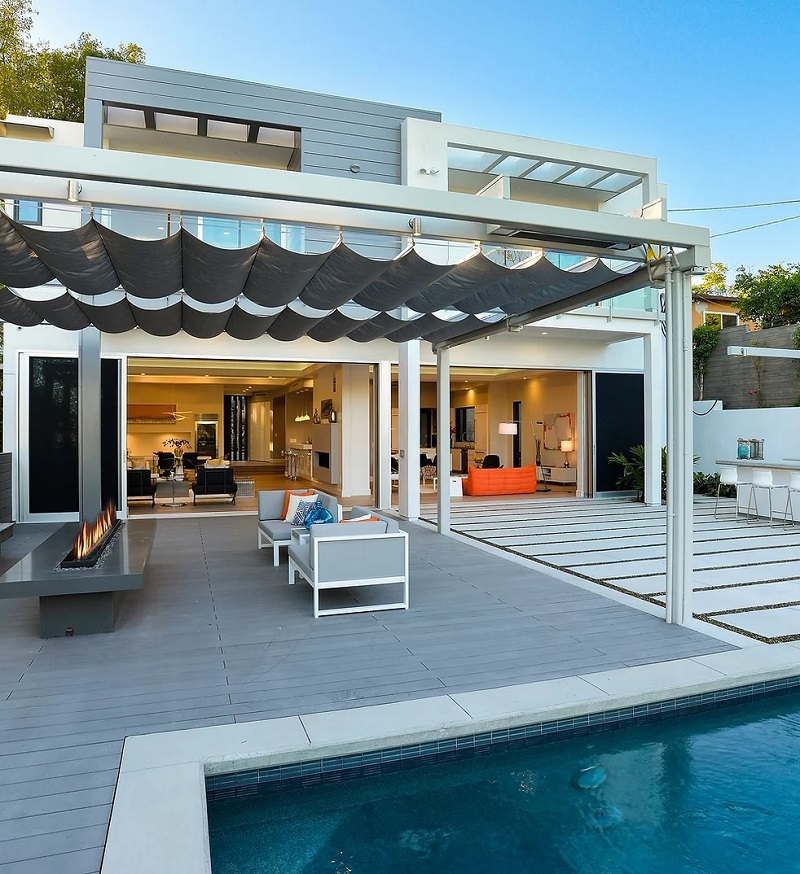
Photo courtesy of Infinity Canopy.
Examples of Flexible Shade Sails
- Ashadya (Wave Shade Retractable Shade Covers)
- Infinity Canopy (Retractable Shade Sail Canopies)
- Maanta Motorized Roll-Up Sail Umbrella
- Texstyleroofs
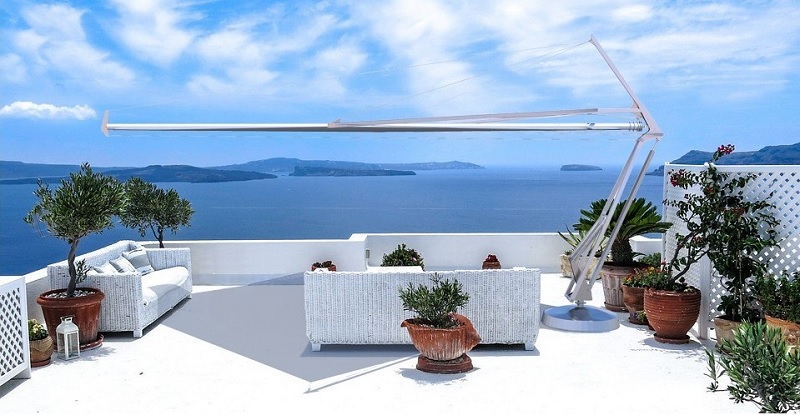
Photo courtesy of Maanta.
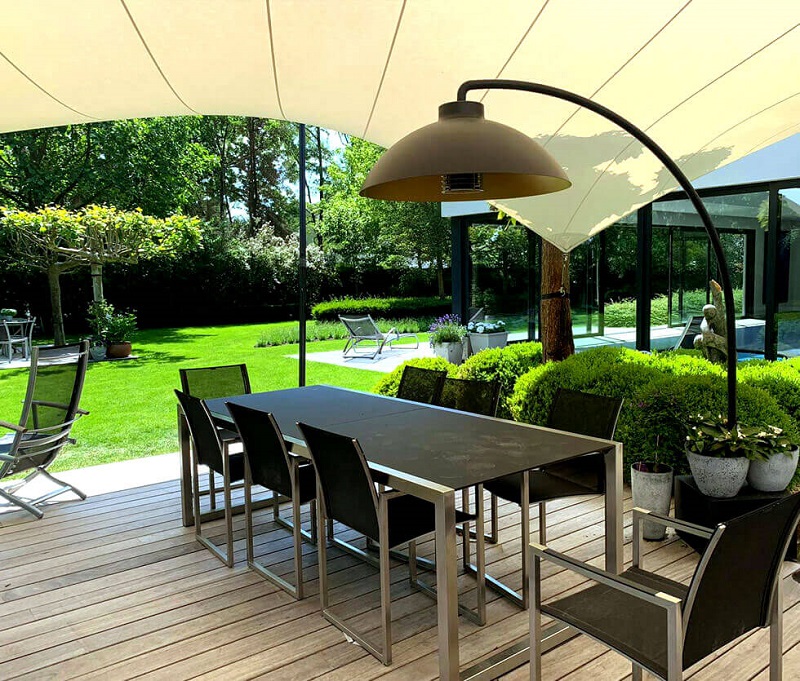
Photo courtesy of Texstyleroofs.
Best Shade Sail Brands
- Colourtree USA
- Coolaroo
- Eden’s Decor
- Kanagawa
- Maanta Outdoor
- MTN Shadesmith
- Patio Paradise
- Quictent
- Shade & Beyond
- Shade Sails
- Tenshon
- Texstyleroofs USA
Shade Sail Resources
- Arizona Shade Sails
- Shade Sail Comparison Chart by BackyardCity
- Shade Sail Cost Calculator by OC Shade Sails
- Tenshon Shade Sail Structure Kits
Related Articles
- How to Choose UV Window Film for Your Home
- Where to Buy Stylish Decorative Privacy Window Film
- The New American Remodel 2021: Sustainable & Energy Efficient Beauty
- 10 Exceptional Products in the New American Home 2021
- The 411 on Phantom Screens: A Profile in Innovation
| Purgula is reader-supported. When you click on links to other sites from our website, we may earn affiliate commissions, at no cost to you. If you find our content to be helpful, this is an easy way for you to support our mission. Thanks! Learn more. |

